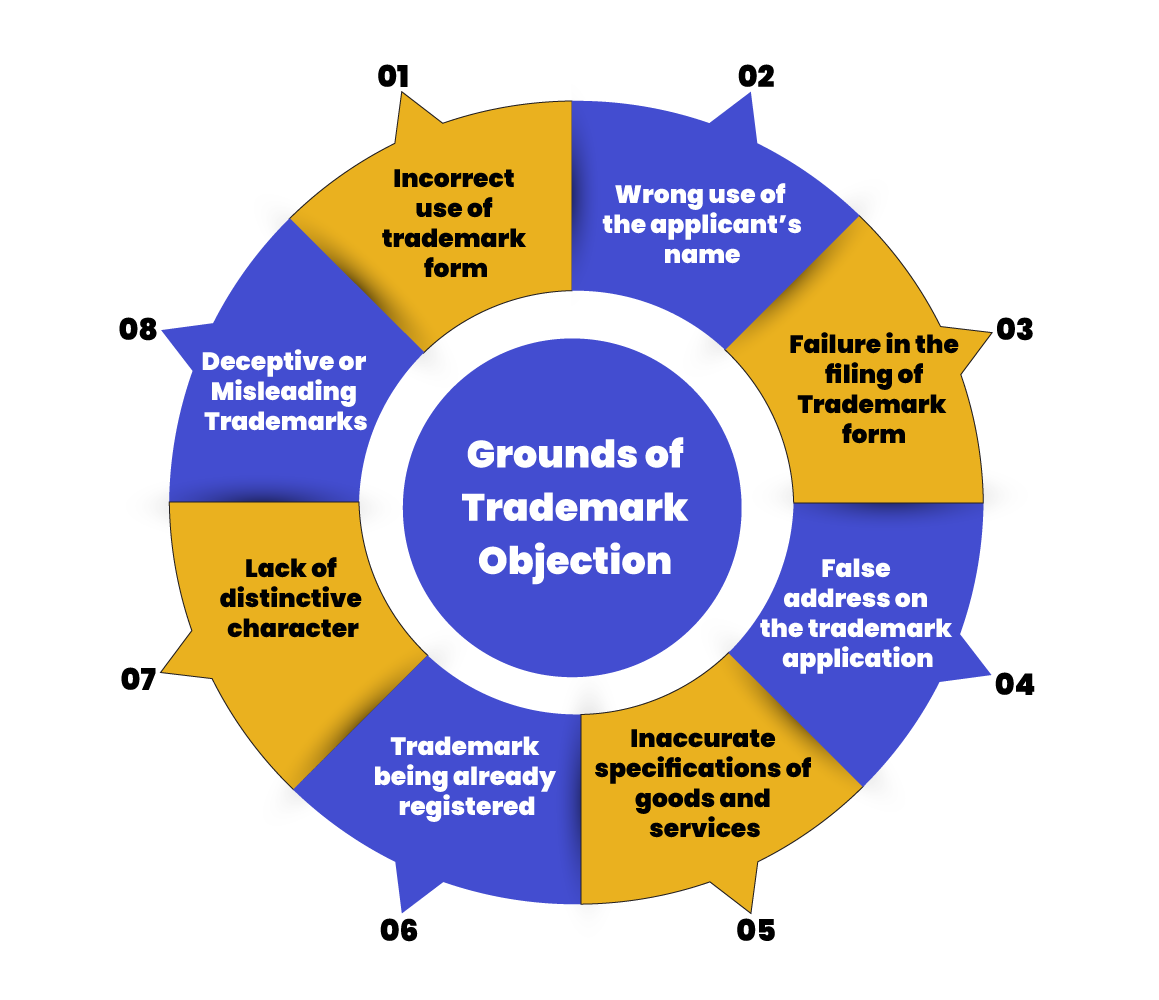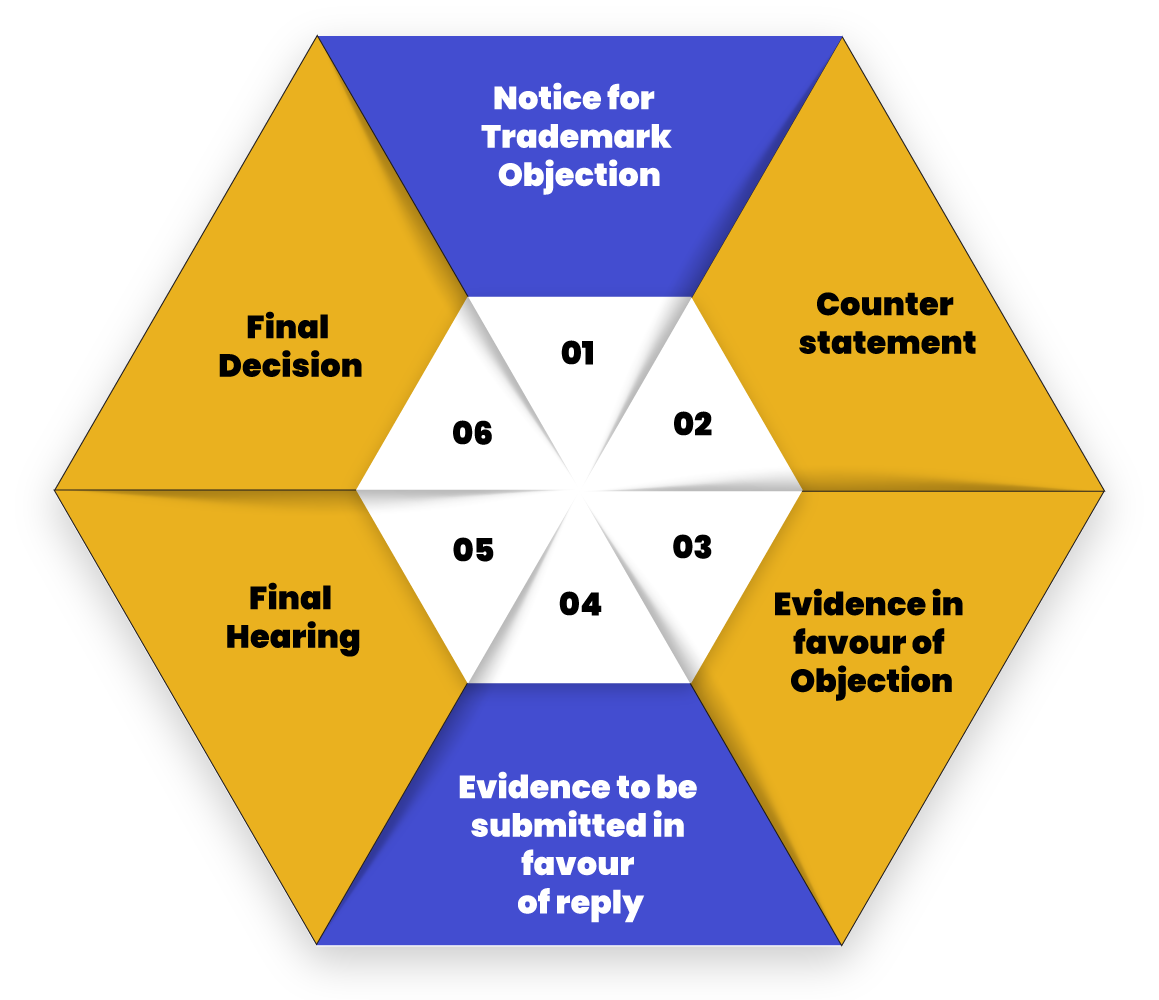An Overview of Trademark Objection
Trademark Objection in India is considered to be the most crucial and important stage for the registration of Trademark. Hence, after filing the application for registration of Trademark, the Trademark officials specifically examines them and analyzes the same application & the mark.
Registration of Trademark application can be rejected by the Authority on various grounds if they deem fit to do so. Many at times during the process of trademark registration, the Trademark Registrar may raise objections on the intended trademark if it seems to violate any rules and laws of trademark registration.
Grounds of Trademark Objection
Following are some of the reasons by which an application for Trademark Registration can face objection:
- Incorrect use of trademark form
- Wrong use of the applicant’s name
- Failure in the filing of Trademark form
- False address on the trademark application
- Inaccurate specifications of goods and services
- Trademark being already registered
- Lack of distinctive character
- Deceptive or Misleading Trademarks

Incorrect use of trademark form
An objection can be raised by the examiner of trademark if in case the application is made in a wrong form or an inappropriate form.
Wrong use of applicant’s name
The name entered in the application must have the names of all partners or authors or owners and must be filed in the name of a partnership firm. Further, the same must be filed on TM-16.
Failure in the filing of Trademark form
Whenever a Trademark attorney or an agent requests of the application for the registration of Trademark, it must be filed under form TM-48 along with the letter authorizing the attorney or the agent. However, in case of any such failure, the trademarks to be registered might get objected.
False address on trademark application
The registration of any trademark could be objected by the Registrar if the application filled shows any incorrect or false address of the applicant. The form filled must contain a valid address.
Inaccurate specifications of goods and services
The examiner can raise questions if the application filled shows the vague number for goods and services in the list. However, if such an objection is raised by the examiner, the applicant must file a request on form TM-16 to remove the objection. Further, the applicant should list down the exact items for which the Trademark is sought.
Trademark already being registered
The application for Online Trademark registration can be objected on the ground if the examiner or the authorized person is of the view that the logo or symbol or sign for which the Trademark has been applied for is already being registered under the Register of Trademarks. This objection can be raised under section 11(1) of the Trademarks Act.
Lack of distinctive character
Such Trademarks which are unable to differentiate between the goods and services of one person from the goods and services of another can be raised for the process of Trademark objection. In order to overcome such a situation, the applicant must provide proof that the Trademark is distinctive in nature and has a character of its own.
Deceptive or Misleading Trademarks
The Trademark examiner can raise the objection if he feels that the trademark to be registered can either deceive or mislead the public in terms of its use, nature or quality or can provide any misleading information. However, in such a case, the applicant may choose to apply for exemption of goods and services from this specification by filing TM-16.
Who Can File For Trademark Objection?
As mentioned under Section 21 of the Trademarks Act, 1999 ‘any person’ can file for the objection of trademark.This may include individuals, companies, partnership firms and trusts. However, if two or more persons have similar issues against any particular trademark to be registered, they can join together as opponents.
Further following personnel can file for the objection of a trademark:
- The author or the owner of an earlier trademark application covering Trademarks for similar goods.
- A person who has already used a similar trademark before the client, but has not sought registration of the same trademark. (Prior User)
What is The Time Period for Trademark Objection?
The third-party can file for the objection of trademark within the period of three months which may be extended to an additional one month from the date of publication of such trademarks.
Where Can Notice For Trademark Objection Be Filed?
The notice for the purpose of trademark objection can be filed at the trademark registry where the application for the trademark in the conflict has been filed earlier. Thus, it can be stated that if an application is filed at Delhi office, then the proceedings for objection of trademark should also be initiated at Delhi office only. Also know the Top Ten Reasons for Trademark Objection in India.
What is The Procedure for Trademark Objection in India?
The following steps are involved in the process for the objection of trademark in India:

Notice for Trademark Objection
Any person can file for a notice of objection on a trademark that has already been advertised and published in the trademark journal within 4 months from the date of advertisement.
Counter statement
The applicant can file for the counter-statement within 2 months from the date of the receipt of notice of trademark objection. If not done so, the applicant seems to have abandoned the Trademark application.
Evidence in favour of Objection
The applicant may by way of an affidavit, can file for the evidence in favour of the objection of trademark. The applicant can also write to the Registrar of the Trademark stating that the applicant does not want to file evidence but instead intends to rely upon the facts stated in the notice for trademark objection.
Evidence to be submitted in favour of reply
The opponent party is provided with a duration of one month which may extend for a period of another one month in order to file for evidence in response to the applicant’s evidence.
Final Hearing
Based on all of the above points and the evidence produced and submitted, the Registrar shall call for the hearing. The parties within the period of 14 days from the date of receipt of the notice of hearing shall notify the registrar for their appearance in the matter. Thus, the matter is then heard by the Registrar of the Trademark and then decided on the basis of merits.
Final Decision
After the hearing on the matter, the Registrar finally delivers the decision. If the decision is in favour of the applicant, then such application is registered as per the Trademark Registration Act. However, if the decision is against the applicant, such Trademarks are considered to be objected by the Registrar.
FAQs of Trademark Objection
You need to prepare a reply to the objection raised by the authorities within the specified time period. However, it is always advised to take professional assistance for filing your reply.
In case an applicant’s trademark application gets objected by the authorities, then he/she must file a reply within the time specified, starting from the date of receipt of the objection report.
The term “opposed” means that a third party has found the mark objectionable.
Any person can oppose a Trademark Application filed in India. That means only thirty party doesn't need to have the right to oppose a Trademark.
In case your trademark gets denied, in that case, you have the power to challenge the decision passed by the trademark registry or can even file to review its decision.
To oppose a registered trademark in India, one needs to file an application, together with the grounds for opposition.
Yes, one can challenge a registered trademark in India, if the same violates or infringes the rights of a Trademark Holder.
A trademark remains valid for a period of 10 years and is eligible to obtain renewal after expiry.
One can either check the status of the application by visiting the official trademark Registry Portal.
One can either check the status of the application by visiting the official trademark Registry Portal. Over there, enter the reference number provided at the time of Trademark Registration.
The different types of Trademark Symbols are TM, SM, and R.
The registered owner of a goods and services gets to benefit from a Trademark.
Yes, it is possible to remove a registered trademark from the register by filling an application to the registrar in the specified format. One also needs to mention the reason for striking off the name.
Yes, a Registrar can strike-off a name on a suo motu basis.


